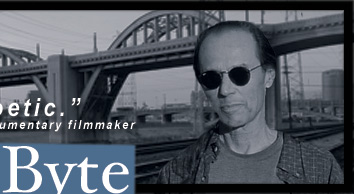
 |
The Future of Freeway Communication
The first time I saw a freeway message sign was on the 5 near Katella in Anaheim. CalTrans had just installed the variable ambered-bulbed overhead billboard and was running a test, so the entire grid of the sign was lit — no message, just a matrix of amber. It nearly stopped freeway traffic. Motorists were so mesmerized by the simple dot matrix pattern, they slowed to a near standstill. Lately, Cal Trans has used these freeway boards for posting the commandment, “Report Drunk Drivers, Call 911.” I once reported a drunk driver. He was in heavy stop and go traffic on the East LA interchange — cutting from lane to lane, slamming on his brakes, and brandishing a bottle of unidentifiable liquor in a brown paper bag from which — when the spirit moved him — he took a long draw. Let’s just call him the complete drunk driver cliché. We both ended up, the cliché and I, in the slow lane — he behind me as we passed the source of the traffic jam: a fender bender moved to the shoulder with the highway patrol in attendance taking notes. Next to the accident, I came to a stop, yelled to an officer, “The guy behind is drunk” and pointed. Pulling away, looking at my rear view mirror, I could see the drunk driving arrest in progress. Cheer, boo or hiss all you want, I like to think of my act as a old school humane way to rat out a drunk at the wheel. The new Caltrans method, calling 911 may be a socially networked police informant approach, but it brings up a whole host of issues: Should I call 911 to report angry drivers? Asshole drivers? Drivers putting on makeup? Drivers who appear to be spliffin’? Distracted drivers? (Like those who can’t stop reading freeway message signs?) But enough. The “Report Drunk Drivers, 1-800” amber alert freeway message does suggest the possibility for a new public-private partnership use of these signs. The idea was originally conceived by our Austrian Governor Arnold Schwarzenegger in 2008. Arnold wanted to use the message signs for commercial billboards — for rent, when they weren’t in use by Caltrans. By selling ads, Arnie reasoned, California could raise funds that would not only go to freeway maintenance, but to improvements in the signage. The old dot matrix readouts would have been, presumably, upgraded to video displays screening ads, animated color-coded traffic alerts and actual footage of an amber alert child and the car involved in an abduction. This, in turn would generate more ads. Soon we’d have mini-movie trailers, Dancing with the Stars promos and Cymbalta, Mad Men and Geico 5-second spots. But why stop there? In between our freeway amber ads we could have programming. Granted they’d be short programs — a few seconds tops, but our communication shrinking skills have grown up since we’ve been online and tweeting. Cruising down the 405, we could be entertained with a short film art project. Why not? Maybe a Chris Burden Metropolis 2 loop, or a Jeff Koons balloon car blow up. Imagine a 405 short poetry contest, traffic koans like: Next up, Accident ahead. A public service announcement from CalTrans: Keep your eyes on the road. Not now. I’ve got to report a drunk. — Nathan
Callahan © NathanCallahan.com / Nathan Callahan / all rights reserved |
Broadcasting Fridays at 8:50 am from KUCI 88.9 fm Orange County, California
|